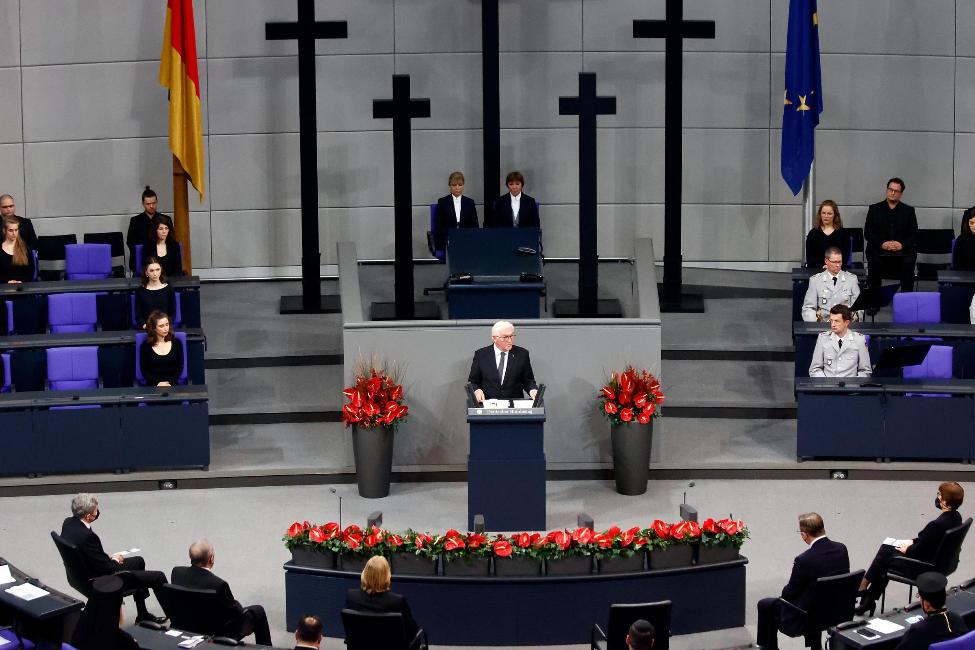As head of state, the Federal President is particularly well placed to embody the state, represent it and integrate the various social groups within it. All activities in this field, above all decisions on designating state symbols, fulfilling representational duties, becoming a patron of organizations, delivering addresses, making speeches and ordering official ceremonies and state funerals can be summarized under the heading representing the state. This is a very broad field for which there is often no legal basis.
National anthem
The Federal President designates state symbols in so far as the legislator does not assume the role (cf. Art. 22 of the Basic Law: the federal flag shall be black, red and gold). Alongside the federal flag, the national anthem is the most well-known state symbol. Back in 1922 Friedrich Ebert, at that time President of the Reich, by decree declared the ""Song of the Germans"" written in 1841 by August-Heinrich Hofmann von Fallersleben for Haydn's Austrian Imperial Anthem, to be the German national anthem.
In 1952 the then Federal President Theodor Heuss decided to take it over as the national anthem of the Federal Republic of Germany, but instructed that only the third stanza be sung on state occasions. After German reunification President von Weizsäcker, in an exchange of letters on the matter with the Chancellor, Helmut Kohl, declared the third stanza to be the national anthem of the German people.
Flags, coats of arms, uniforms
Flags, coats of arms, uniforms and judges' robes are also state symbols. The Federal President has given relevant instructions published in the Federal Law Gazette.
Official ceremonies, state funerals
The Federal President can order a state funeral or an official ceremony to be held on the death of a public figure who has rendered distinguished services to Germany. A state funeral usually includes a military and a religious ceremony. Official ceremonies are political acts that take place in a ceremonial setting and cannot simply be ordered to pay tribute to someone who has passed away. On the occasion of German reunification on 3 October 1990 the then Federal President, Richard von Weizsäcker, ordered an official ceremony to take place at the Berlin Philharmonic.
Other ways of representing and integrating
Apart from such formal occasions, the Federal President represents our country in many different ways and at many different events. The President embodies the state every time he appears in public, every time he participates in an event, assumes a patronage, makes a speech, conveys congratulations, takes part in a tour or a wide range of other activities. He thus sets an example of recognition, goodwill or particular support. Nevertheless there is a limit to what events the Federal President can take part in. They have to be of national relevance and special significance.
Speeches and addresses
The written and spoken word is one of the most effective ways the Federal President has to act politically.
Through his speeches he can focus the attention of the public as well as government, party and community leaders on particular issues and problems in political life and society as a whole, he can generate debate and encourage new ideas.
Letters and requests
Many people write to the Federal President with requests, questions or complaints. Their letters testify to the great trust people place in him to help with their problems and concerns. Given the constitutional limits to his competences and scope for action, however, people often expect more than the Federal President can deliver.
All letters addressed to the Federal President are attentively read and any points raised considered on their merits. Should such action be justified, the Federal President will pursue all avenues open to him to help.
Depending on the circumstances, the Federal President will take the problem up with the relevant federal, Land or municipal authorities - particularly the Social Security Offices - as well as charity or other organizations.
Often the mere fact that the Federal President himself or an aide acting on his instructions has asked the relevant officials for information about a particular case is sufficient to ensure a citizen's problem is taken seriously or gets the attention it deserves.
The Federal President as patron
In agreeing to become a patron, the Federal President as head of state is expressing the state's special interest in a particular organization, event or initiative and highlighting its importance.
The Federal President can only become a patron if the relevant organization or event has a beneficial impact on the whole country and stands on a secure legal, administrative and financial footing. By reason of his constitutional position, the Federal President will normally be the sole patron of an organization or event. Only in conjunction with another head of state can he be a joint patron.
The decision to become a patron is always the personal decision of the Federal President and valid only for his own term of office. He is in no way bound by his predecessors' decisions, nor can he influence the decisions of his successors in this respect.


